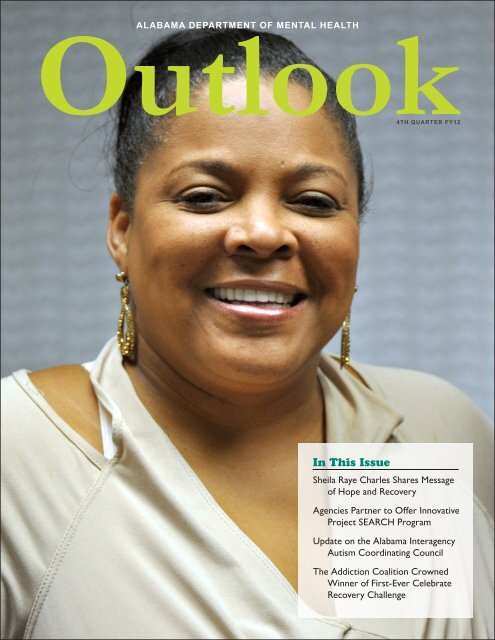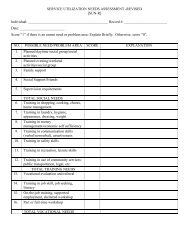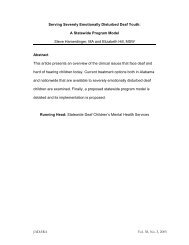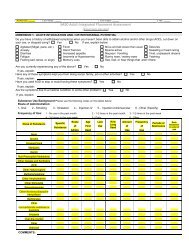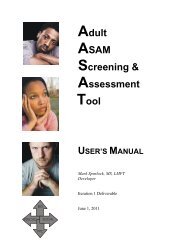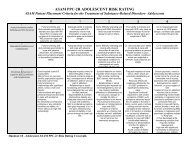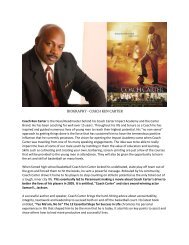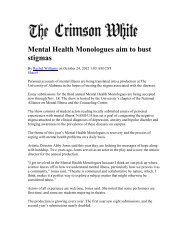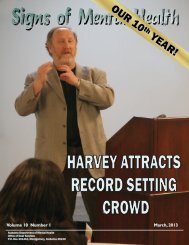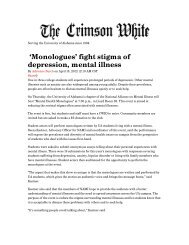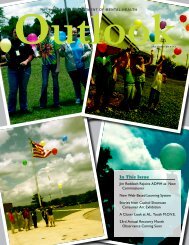4th Qtr - Alabama Department of Mental Health - Alabama.gov
4th Qtr - Alabama Department of Mental Health - Alabama.gov
4th Qtr - Alabama Department of Mental Health - Alabama.gov
You also want an ePaper? Increase the reach of your titles
YUMPU automatically turns print PDFs into web optimized ePapers that Google loves.
Outlook<br />
ALABAMA DEPARTMENT OF MENTAL HEALTH<br />
4TH QUARTER FY12<br />
In This Issue<br />
Sheila Raye Charles Shares Message<br />
<strong>of</strong> Hope and Recovery<br />
Agencies Partner to Offer Innovative<br />
Project SEARCH Program<br />
Update on the <strong>Alabama</strong> Interagency<br />
Autism Coordinating Council<br />
The Addiction Coalition Crowned<br />
Winner <strong>of</strong> First-Ever Celebrate<br />
Recovery Challenge
On the cover:<br />
Sheila Raye Charles<br />
Table <strong>of</strong> Contents<br />
2<br />
3<br />
4<br />
5<br />
6<br />
8<br />
9<br />
10<br />
Governor Appoints Bennett, Perdue and Phillips to ADMH’s Advisory Board <strong>of</strong> Trustees<br />
Four ADMH Employees Receive Awards<br />
ADMH Closes Greil & Searcy Hospitals<br />
Pictures <strong>of</strong> new hospital construction<br />
Sheila Raye Charles Shares Message <strong>of</strong> Hope and Recovery<br />
Agencies Partner to Offer Innovative Project SEARCH Program<br />
Update on the <strong>Alabama</strong> Interagency Autism Coordinating Council<br />
ADMH Employees Participating in State Combined Campaign<br />
The Addiction Coalition Crowned Winner <strong>of</strong> First-Ever Celebrate Recovery Challenge<br />
Exercise Your Right and Vote!<br />
Ben Arthur’s “Floodgates” Video<br />
Outlook is the quarterly newsletter <strong>of</strong> the <strong>Alabama</strong> <strong>Department</strong> <strong>of</strong> <strong>Mental</strong> <strong>Health</strong>. It provides information about department<br />
initiatives, community mental health services, individual success stories and relevant national topics. Published four times<br />
annually, Outlook can be delivered to your inbox or viewed online @ www.mh.alabama.<strong>gov</strong>/COPI/MediaCenter.aspx.<br />
Questions, suggestions and comments about Outlook should be sent to the Office <strong>of</strong> Public Information & Community<br />
Relations. Contact PICR at 334-242-3417.<br />
Editor - Kristi Gates<br />
Design - Peggy Olson
<strong>Department</strong> News<br />
Governor Appoints Bennett, Perdue<br />
and Phillips to ADMH’s Advisory Board<br />
<strong>of</strong> Trustees<br />
Also Reappoints Wade Perry Jr.<br />
David Bennett, Probate Judge<br />
Jim Perdue and Circuit Judge<br />
Laura Brown Phillips were<br />
recently appointed, effectively immediately,<br />
to the <strong>Alabama</strong> <strong>Department</strong> <strong>of</strong> <strong>Mental</strong><br />
<strong>Health</strong>’s Advisory Board <strong>of</strong> Trustees by<br />
Governor Robert Bentley. Wade Perry<br />
Jr., a current member <strong>of</strong> the board<br />
initially appointed in 2008, was also<br />
reappointed by Bentley.<br />
Bennett represents the Seventh<br />
Congressional District and will serve<br />
until his term expires April 2015.<br />
He retired from ADMH as associate<br />
commissioner for the Division <strong>of</strong><br />
Administration in 2008 after more than<br />
17 years with the department. Prior<br />
to that position, Bennett was facility<br />
director at Bryce Hospital and served<br />
in a number <strong>of</strong> other positions at Bryce<br />
throughout his career with ADMH. He<br />
is a graduate <strong>of</strong> Stillman College with a<br />
bachelor’s <strong>of</strong> sociology. He also holds<br />
a master’s from the University <strong>of</strong> West<br />
<strong>Alabama</strong> in guidance and counseling.<br />
Bennett is currently serving as pastor<br />
<strong>of</strong> the First Missionary Baptist Church<br />
in Moundville and president <strong>of</strong> the<br />
Congress <strong>of</strong> Christian Education for<br />
the New Antioch Bethlehem District <strong>of</strong><br />
Tuscaloosa and north Hale County. He<br />
has been involved in community service<br />
in the west <strong>Alabama</strong> area for many<br />
years, having served on a number <strong>of</strong><br />
volunteer boards.<br />
Perdue is representing the Second<br />
Congressional District and serving a term<br />
that will expire April 2014. He has served<br />
as probate judge for Crenshaw County<br />
since 2002. Prior to that, Perdue worked<br />
as the president & CEO <strong>of</strong> the Perdue-<br />
Folmar Company, Inc., since 1980. He holds<br />
a bachelor’s in accounting from Auburn<br />
University. Perdue has been a fixture in<br />
his community’s volunteer efforts, having<br />
served as past president <strong>of</strong> the Luverne<br />
Rotary Club, Crenshaw County Chamber<br />
<strong>of</strong> Commerce, Crenshaw County Industrial<br />
Development Board and board member on<br />
Longtime ADMH Advisory Board <strong>of</strong><br />
Trustees member and respected newspaper<br />
executive Paul Davis passed away at his<br />
home in Auburn in late September. Davis<br />
served as a reporter and associate editor <strong>of</strong><br />
The Tuscaloosa News, where he uncovered<br />
problems at Bryce Hospital and W.D. Partlow<br />
Developmental Center in the late 1960s and<br />
early 70s. Eventually, his coverage garnered<br />
national attention and led to the Wyatt v.<br />
Stickney case, which set new national standards<br />
for the care <strong>of</strong> persons with mental illnesses<br />
and developmental disabilities, requiring the<br />
state to provide adequate care. He also served<br />
as editor <strong>of</strong> The Selma Times-Journal, general<br />
manager <strong>of</strong> The Natchez Democrat in Mississippi,<br />
and publisher and editor <strong>of</strong> The Auburn Bulletin,<br />
The Tuskegee News and Tallassee Tribune.<br />
ADMH Commissioner Jim Reddoch<br />
said, “Paul was a giant in his chosen field <strong>of</strong><br />
journalism. I can think <strong>of</strong> no one in <strong>Alabama</strong><br />
who had a greater positive impact on the<br />
rights and treatment <strong>of</strong> persons with mental<br />
illnesses over the past 45 years. He was an<br />
active member <strong>of</strong> ADMH’s Advisory Board<br />
<strong>of</strong> Trustees, always keeping mental health<br />
consumers as the absolute first priority. He will<br />
be missed tremendously.”<br />
a number <strong>of</strong> other civic organizations.<br />
Perry represents the First Congressional<br />
District and will serve a term expiring<br />
April 2015. He began his career as a federal<br />
prosecutor in Montgomery, and has been<br />
with the Mobile law firm <strong>of</strong> Johnstone,<br />
Adams, Bailey, Gordon & Harris, L.L.C.,<br />
since 1975. Perry’s practice has been<br />
involved in extensive employment law<br />
litigation as well as regularly advising<br />
clients in all areas <strong>of</strong> health and hospital<br />
law, related statutes and regulations. He<br />
received an undergraduate degree from<br />
Davidson College and a law degree from<br />
Vanderbilt University. The Eufaula native<br />
is a member <strong>of</strong> the American Academy<br />
<strong>of</strong> <strong>Health</strong>care Attorneys.<br />
Phillips fills the remainder <strong>of</strong> the term<br />
<strong>of</strong> Paul Davis, who recently passed. She<br />
represents the Third Congressional<br />
District until the term expires in April<br />
2013. Phillips has served as district<br />
court judge in the 7th Judicial Circuit<br />
since 2004. Prior to that position, she<br />
worked in several positions in the 7th<br />
Judicial Circuit District Attorney’s<br />
Office, including supervisor <strong>of</strong> the<br />
Family Violence Trial Division, assistant<br />
district attorney, felony intake <strong>of</strong>ficer/<br />
victim’s service <strong>of</strong>ficer and clerk. Phillips<br />
holds a bachelor’s in political science<br />
from Jacksonville State University and a<br />
law degree from the Birmingham School<br />
<strong>of</strong> Law.<br />
Phillips is a current member <strong>of</strong> the<br />
<strong>Alabama</strong> Bar Association and Calhoun<br />
County Bar Association. She has been<br />
a member <strong>of</strong> numerous pr<strong>of</strong>essional<br />
and community organizations including<br />
the National District Attorney’s<br />
Association, <strong>Alabama</strong> District<br />
Attorney’s Association, <strong>Alabama</strong><br />
Supreme Court’s Standing Committee<br />
on Juvenile Rules and Procedure,<br />
Calhoun County Family Services Board<br />
<strong>of</strong> Directors, and Calhoun and Cleburne<br />
County Child Trauma Team. Phillips was<br />
a founding member <strong>of</strong> the Calhoun and<br />
Cleburne County Child Death Review<br />
Team, the Calhoun County Task Force<br />
Against Domestic Violence and LINC.<br />
2
<strong>Department</strong> News<br />
Four ADMH Employees Receive Awards<br />
Pr<strong>of</strong>essional Achievements <strong>of</strong> Crump, Darling, Davis and Stone Lauded<br />
ADMH is pleased to announce<br />
the recent presentations <strong>of</strong><br />
pr<strong>of</strong>essional achievement awards<br />
to four employees. Charlene Crump and<br />
Wendy Darling, both in the department’s<br />
Office <strong>of</strong> Deaf Services, received awards<br />
during the 2012 joint <strong>Alabama</strong> Registry <strong>of</strong><br />
Interpreters for the Deaf and Council on<br />
Organizations Serving Deaf Alabamians<br />
Annual Conference in August. In addition,<br />
ADMH Historian Steve Davis and Medical<br />
Director Dr. Timothy Stone received<br />
awards from the <strong>Alabama</strong> chapter <strong>of</strong> the<br />
National Alliance on <strong>Mental</strong> Illness at their<br />
26th Annual Meeting, also held in August.<br />
Crump, statewide mental health<br />
interpreter coordinator, received ALRID’s<br />
2012 Mary Lou Bingham Award. The<br />
award, presented biennially as a lifetime<br />
achievement award, is given in honor <strong>of</strong><br />
<strong>Alabama</strong>’s first pr<strong>of</strong>essional interpreter<br />
and champion for the pr<strong>of</strong>essionalism<br />
<strong>of</strong> interpreting. It recognizes significant<br />
contributions and achievements toward<br />
improving the pr<strong>of</strong>ession <strong>of</strong> interpreting<br />
in the state. The award joins a long list <strong>of</strong><br />
Crump’s accolades, including <strong>Alabama</strong>’s<br />
Executive Branch Employee <strong>of</strong> the Year in<br />
2010, ADMH’s Central Office Employee <strong>of</strong><br />
the Year in 2009, AAD Citizen <strong>of</strong> the Year<br />
in 2007, SERID Interpreter <strong>of</strong> the Year in<br />
2004 and COSDA Interpreter <strong>of</strong> the Year<br />
in 2002. As Steve Hamerdinger, director<br />
<strong>of</strong> the Office <strong>of</strong> Deaf Services noted in<br />
nominating Crump for this most recent<br />
honor, “She will modestly brush <strong>of</strong>f these<br />
acclamations, but together, they attest to<br />
the esteem those who work with her and<br />
who are exposed to<br />
her<br />
commitment and passion hold her.”<br />
Darling, a regional interpreter in ODS,<br />
was awarded the Interpreter <strong>of</strong> the Year<br />
Award from COSDA. In presenting the<br />
award to Darling, Hamerdinger said it was<br />
going, “To someone who has few peers<br />
in the interpreting world with regard to<br />
her energy, compassion and dedication to<br />
working with some <strong>of</strong> the most challenging<br />
consumers we have.” Darling is the only<br />
person in the department holding a national<br />
certification to work with people who<br />
are both deaf and blind. She is admired<br />
by her peers for her untiring devotion to<br />
ensure consumers are receiving needed<br />
services, her ability to analyze and respond<br />
effectively and efficiently to requests<br />
and problems, and her positive energy.<br />
Hamerdinger also stated, “She exemplifies<br />
the very best <strong>of</strong> what civil service should<br />
be.” Darling’s Interpreter <strong>of</strong> the Year<br />
Award joins another recent recognition as<br />
ADMH’s FY 12, 2nd quarter Central Office<br />
Employee <strong>of</strong> the Quarter.<br />
NAMI <strong>Alabama</strong> presented Davis with<br />
the 2012 Lifetime Achievement Award for<br />
a career <strong>of</strong> promoting and preserving the<br />
history <strong>of</strong> the treatment <strong>of</strong> persons with<br />
mental illnesses. During the presentation,<br />
Wanda Laird, executive director <strong>of</strong> NAMI<br />
<strong>Alabama</strong>, stated, “Steve Davis has been<br />
dedicated to preserving the history <strong>of</strong><br />
both Bryce Hospital and the <strong>Alabama</strong><br />
<strong>Department</strong> <strong>of</strong> <strong>Mental</strong> <strong>Health</strong>. The<br />
breadth and quality <strong>of</strong> his work to preserve<br />
documents and other physical objects only<br />
begins to speak to his commitment to<br />
ultimately preserve, honor and respect<br />
the memory <strong>of</strong> all persons, both known<br />
and unknown, who have been patients at<br />
Bryce over the past 150 years.” Davis has<br />
been with ADMH for 37 years, becoming<br />
department historian in July 2008. This<br />
award joins other recognition from the<br />
national NAMI organization in 2009 for the<br />
best use <strong>of</strong> media for reducing the stigma <strong>of</strong><br />
mental illness.<br />
Stone was the recipient <strong>of</strong> NAMI<br />
<strong>Alabama</strong>’s <strong>Mental</strong> <strong>Health</strong> Pr<strong>of</strong>essional <strong>of</strong> the<br />
Year Award. Stone joined the department<br />
in September 2011, bringing with him<br />
extensive experience in community-based<br />
services as well as inpatient services for<br />
individuals with mental illnesses, substance<br />
use disorders and developmental disabilities.<br />
Laird noted when presenting the award<br />
to Stone, “He has shown a dedication<br />
to expanding the use <strong>of</strong> evidencebased<br />
practices throughout the state’s<br />
mental health system, and fulfilling the<br />
department’s goal <strong>of</strong> integrating services<br />
for persons with co-occurring mental<br />
health and substance use disorders. His<br />
multi-disciplinary background is invaluable<br />
in better serving the overall behavioral<br />
healthcare needs <strong>of</strong> <strong>Alabama</strong>’s citizens.” In<br />
addition to serving on a number <strong>of</strong> boards,<br />
councils and workgroups, Stone has served<br />
as a fellow <strong>of</strong> the American Psychiatric<br />
Association since 2007 and has been<br />
recognized by Best Doctors in America<br />
since 2005.<br />
3
<strong>Department</strong> News<br />
ADMH Closes Greil & Searcy Hospitals<br />
Part <strong>of</strong> Plan to Enhance Network <strong>of</strong> Community-Based Care<br />
In keeping with previously announced<br />
plans, ADMH recently closed Greil<br />
Hospital in Montgomery and Searcy<br />
Hospital in Mt. Vernon. The closures were<br />
announced in April by Governor Robert<br />
Bentley as part <strong>of</strong> the department’s systems<br />
transformation plan to enhance a network<br />
<strong>of</strong> community-based care. The plan and<br />
closures were based on the continuation<br />
<strong>of</strong> nationwide trends including advances in<br />
treatments that allow for comprehensive<br />
care in community settings, as well as<br />
the principle that treatment in a person’s<br />
community is far less isolating and more<br />
conducive to recovery. Along with providing<br />
enhanced community life for consumers,<br />
the facility closures will free up funds to be<br />
transferred to community providers so they<br />
may expand services and resources.<br />
Greil opened in 1974 and traditionally<br />
served Alabamians from 11 counties in the<br />
south central part <strong>of</strong> the state. In July, the<br />
department expanded on the Governor’s<br />
original closure announcement by reporting<br />
an anticipated closure date <strong>of</strong> August 31<br />
for Greil. Per those plans, the department<br />
did <strong>of</strong>ficially close Greil on August 31.<br />
In September, Commissioner Reddoch<br />
held a meeting with Searcy employees to<br />
announce its <strong>of</strong>ficial target closure date <strong>of</strong><br />
October 31. Again, initial projections were<br />
met as the department <strong>of</strong>ficially closed<br />
Searcy on October 31. Searcy opened<br />
in 1902 and served Alabamians from 16<br />
counties in the southern part <strong>of</strong> the state.<br />
As with other hospital closures, each<br />
patient at Greil and Searcy was assessed for<br />
individual needs, and individual plans were<br />
developed for their continued treatment in<br />
the community. Likewise, the small number<br />
<strong>of</strong> patients determined to have needs that<br />
may not be best met in community-based<br />
care were transferred to other state<br />
hospitals to continue receiving services.<br />
ADMH also continued its commitment<br />
to assist staff in finding alternative<br />
employment. Voluntary transfers were<br />
<strong>of</strong>fered to ADMH hospitals in the<br />
Tuscaloosa and Decatur areas, as well<br />
as other positions statewide through<br />
the community mental health and state<br />
personnel systems. In addition, a number<br />
<strong>of</strong> job fairs were held, and ADECA’s Rapid<br />
Response Team visited the facilities to<br />
provide information about unemployment<br />
compensation, pension benefits, job<br />
training, employment services, health<br />
insurance, credit counseling and many<br />
other services. The department utilized a<br />
team to finalize administrative and logistical<br />
procedures at each <strong>of</strong> the facilities following<br />
their closure.<br />
Construction progress continues on the new psychiatric hospital,<br />
located in Tuscaloosa.<br />
Overhead shot <strong>of</strong> construction on new psychiatric hospital.<br />
4
Consumer Story<br />
Sheila Raye Charles Shares Message <strong>of</strong><br />
Hope and Recovery<br />
Visit to Capital City part <strong>of</strong> <strong>Alabama</strong>’s celebration <strong>of</strong> National Recovery Month<br />
Contributed by Jeff Shackelford<br />
Many people know the story <strong>of</strong><br />
Ray Charles. The entertainer<br />
overcame blindness, redefined<br />
rock and soul music, and won multiple<br />
Grammys along the way. Many also know<br />
the story <strong>of</strong> his drug and alcohol abuse<br />
thanks to Jamie Foxx’s Oscar-winning<br />
performance in the hit movie, Ray. What<br />
many may not know is that his daughter,<br />
Sheila Raye Charles, shares not only her<br />
father’s name, but also his story <strong>of</strong> drugs,<br />
music and, ultimately, recovery. Sheila<br />
came to Montgomery recently to tell<br />
that story at Freewill Missionary Baptist<br />
Church as part <strong>of</strong> <strong>Alabama</strong>’s celebration<br />
<strong>of</strong> National Recovery Month.<br />
Sheila recalled for the audience her<br />
early years and said she did not grow<br />
up living with her famous father, but<br />
with her mother in Minnesota. She<br />
stated her mother battled alcoholism<br />
and was a socialite who took Sheila<br />
to the many parties she attended.<br />
Her mother was unaware that<br />
some <strong>of</strong> the men at these parties<br />
were been sexually abusing Sheila.<br />
She remarked, “Having a father<br />
like Ray Charles was both a blessing and a<br />
curse. I found myself not knowing how to<br />
cope with those issues or cope with people<br />
always wanting to be around me because I<br />
was his daughter. Because <strong>of</strong> my childhood<br />
and the sexual abuse, I felt very unworthy.<br />
By the time I was 16, I had tried everything<br />
except heroin. I think I never tried it<br />
because my mom always talked about my<br />
dad and his heroin use.” However, Sheila<br />
did go on to abuse other substances such as<br />
acid, marijuana, alcohol and crack cocaine.<br />
She said drugs seemed to solve her<br />
problems, “By the time I was 18, I had my<br />
first experience with crack cocaine. As<br />
soon as I took a puff <strong>of</strong> that stuff, the sun<br />
was brighter, and the grass was greener.<br />
I felt beautiful. I’d never felt beautiful due<br />
to the sexual abuse. All the hurt literally<br />
disappeared.” Sheila later decided to follow<br />
in her father’s footsteps and became a<br />
pr<strong>of</strong>essional singer. Unfortunately, she did<br />
not have the same success as her father, and<br />
the pain <strong>of</strong> touring and politics <strong>of</strong> the music<br />
business took a toll on her. The easy access<br />
to drugs would also take a toll, resulting in<br />
a downward spiral that found Sheila living<br />
out on the street. She was only 21 years old<br />
and knew her life was a mess. After falling in<br />
love and becoming pregnant, Sheila<br />
thought she would<br />
Charles visited with Associate Commissioner for Division <strong>of</strong> <strong>Mental</strong><br />
<strong>Health</strong> & Substance Abuse Services Dr. Beverly Bell-Shambley while<br />
in town for her appearance at a recent Recovery Month event.<br />
have a family and get<br />
the happy ending she always wanted.<br />
However, after having a daughter, she<br />
began using again. The more she tried to<br />
escape her pain, the more pain she felt.<br />
Sheila went on to have four more children<br />
by four separate fathers and used drugs<br />
during her pregnancies. She thought she<br />
hit rock bottom when her son was born<br />
prematurely weighing 14 ounces and with a<br />
hole in his heart, but things got worse when<br />
she found out he was also addicted to crack<br />
cocaine. Her only way <strong>of</strong> dealing with this<br />
was using more. Sheila continued to take<br />
drugs while in the hospital with her son.<br />
Eventually, she lost custody <strong>of</strong> her children<br />
and went to prison three separate times.<br />
In 2003, when Sheila was serving her<br />
third sentence at a federal prison in Bryan,<br />
Texas, she decided it was time to start<br />
over. She said, “I reached the end. There<br />
was nothing left I could work with and no<br />
future I could see. I had been told I would<br />
never see my children again. I was being<br />
called a menace to society and a detriment<br />
to my children. All <strong>of</strong> these things hit me<br />
on the prison floor.” After much prayer and<br />
committing her life to God, Sheila knew her<br />
life was going to change. She felt that since<br />
she was sober in prison, she could be sober<br />
in society as well. Sheila felt like she was<br />
called into the ministry to share<br />
her message in order to help<br />
others. After she was released<br />
from prison the final time, she<br />
had one relapse, but has been<br />
sober since 2005.<br />
During the course <strong>of</strong> her<br />
addiction and recovery, Sheila’s<br />
mother died <strong>of</strong> cancer, and her<br />
father was dying <strong>of</strong> liver failure.<br />
Over the years, she had grown away<br />
from him because <strong>of</strong> their struggles<br />
with substance abuse. Although,<br />
Sheila did get to say goodbye to her<br />
father. In 2004, when she was told he<br />
would die any day, Sheila called him on<br />
the phone and said, “I love you.” She<br />
recalled, “He said he loved me back. I asked<br />
for his forgiveness, and he gave it to me.” To<br />
this day, Sheila still gets teary eyed thinking<br />
<strong>of</strong> her parents because she feels she never<br />
got to fully share her story <strong>of</strong> recovery with<br />
them. But, Sheila also says she knows they<br />
are looking down at her and are proud.<br />
Ray Charles made the world a better<br />
place through his music. When he toured<br />
the country, people listened and liked what<br />
they heard. Like her father, Sheila now<br />
tours the country, and when she shares her<br />
unique story, it’s hard for people not to like<br />
her inspiring message <strong>of</strong> hope and recovery.<br />
5
<strong>Department</strong> Initiative<br />
Agencies partner to <strong>of</strong>fer innovative<br />
Project SEARCH program<br />
Seeks to secure competitive employment for students with developmental disabilities<br />
When 11 high school seniors in<br />
the Montgomery area leave<br />
for school each morning,<br />
they are actually going to Baptist Medical<br />
Center South in Montgomery to participate<br />
in a unique school-to-work program<br />
called Project SEARCH. This innovative<br />
program focuses on serving young adults<br />
with a variety <strong>of</strong> developmental disabilities<br />
by helping them secure competitive<br />
employment. Project SEARCH’s High<br />
School Transition Program is a one-year,<br />
business-led program that takes place<br />
entirely at the workplace. Developed in<br />
1996 at Cincinnati Children’s Hospital<br />
Medical Center, Project SEARCH has since<br />
grown to over 200 sites across the U.S.,<br />
Canada, England, Scotland and Australia.<br />
In <strong>Alabama</strong>, Project SEARCH began<br />
just this past August. It is a collaboration<br />
between the <strong>Alabama</strong> <strong>Department</strong> <strong>of</strong><br />
<strong>Mental</strong> <strong>Health</strong>, <strong>Alabama</strong> Council for<br />
Developmental Disabilities, <strong>Alabama</strong><br />
<strong>Department</strong> <strong>of</strong> Education, and <strong>Alabama</strong><br />
<strong>Department</strong> <strong>of</strong> Rehabilitation Services and<br />
its Division <strong>of</strong> Vocational Rehabilitation’s<br />
community <strong>of</strong>fices. Byron White, consumer<br />
employment specialist at ADMH, serves as<br />
the statewide Project SEARCH coordinator,<br />
overseeing progress at its two sites: Baptist<br />
Montgomery and Shelby Baptist Medical<br />
Center in Alabaster. White says first<br />
impressions <strong>of</strong> Project SEARCH are very<br />
favorable, “It gives students training in<br />
an exciting environment with more<br />
creative ways to<br />
learn<br />
Marteena (left) with her mentor in Human Relations, Penny (right).<br />
that the schools cannot <strong>of</strong>fer.” He<br />
adds that the goal is to expand<br />
Project SEARCH to two or three<br />
more sites next year and keep<br />
building the program throughout<br />
the state.<br />
Through Project SEARCH,<br />
students learn relevant,<br />
marketable and transferable<br />
skills while immersed in an<br />
actual business. The program<br />
provides real-life work<br />
experience combined with<br />
training in employability<br />
and independent living<br />
skills to help ensure successful<br />
transitions from school to productive adult<br />
life. The Project SEARCH model involves<br />
an extensive period <strong>of</strong> training and career<br />
exploration, innovative adaptations, longterm<br />
job coaching, and continuous feedback<br />
from teachers, job coaches and employers.<br />
As a result, at the completion <strong>of</strong> the<br />
training program, students are employed in<br />
nontraditional, complex and rewarding jobs.<br />
Typically, Project SEARCH serves<br />
students on an Individual Education<br />
Program and in their last year <strong>of</strong> high<br />
school eligibility. Students attend the<br />
program for a full school year (August –<br />
May) at the host business, which provides<br />
access to an on-site classroom for the<br />
students. Once the school year begins, the<br />
first few weeks <strong>of</strong> the program are focused<br />
on new employee orientation,<br />
hands-on skill assessment, and<br />
familiarization with a business<br />
environment. Students develop<br />
a career plan which guides the<br />
internship selection process<br />
and individualized job search.<br />
Sites are staffed by a special<br />
education teacher and one to<br />
three job coaches to meet<br />
the students’ educational<br />
and training needs.<br />
Valerie Johnson is the<br />
on-site coordinator <strong>of</strong><br />
Project SEARCH at<br />
Project SEARCH students working in Central Sterilization (center<br />
and right) pose with their mentor (left).<br />
Baptist<br />
Montgomery, and<br />
is also in charge <strong>of</strong> planning and<br />
teaching the program’s Employment Skills<br />
curriculum. Johnson was formerly a special<br />
education teacher at Sidney Lanier High<br />
School before joining Project SEARCH.<br />
She states, “I saw so many students there<br />
who were not passing school and who<br />
were not going on to fulfill their potential.<br />
I knew there was a need for some kind <strong>of</strong><br />
transitional program and told my principal<br />
that if he heard <strong>of</strong> any opportunities, I<br />
wanted to be involved. Once we learned<br />
about Project SEARCH, I knew it was my<br />
opportunity to truly make a difference.”<br />
Throughout the school year, students<br />
will spend approximately one hour <strong>of</strong> their<br />
day with Johnson working on employability<br />
and functional skills. Classroom activities<br />
are designed around the following focus<br />
areas: team building, getting around the<br />
workplace, workplace safety, technology,<br />
social skills, communication, presentation<br />
skills, interviewing skills, money<br />
management, health and wellness, job<br />
search skills and keeping a job. Johnson<br />
says, “The most rewarding thing about my<br />
work is teaching them new skills, knowing<br />
they are digesting and learning those skills,<br />
and seeing the skills applied outside <strong>of</strong> the<br />
classroom in their internships.”<br />
Those internships make up approximately<br />
6
five hours <strong>of</strong> the student’s school day.<br />
The students at Baptist Montgomery are<br />
currently working in the first <strong>of</strong> three<br />
targeted internships they will complete<br />
by the end <strong>of</strong> the school year. These<br />
internships will enable them to acquire<br />
skills to use in applying for related<br />
positions. Students are also building<br />
communication, teamwork and problemsolving<br />
skills important to their overall<br />
development as a young worker. The<br />
student internships were identified earlier<br />
this year through a collaborative process<br />
involving the teacher, job coach and<br />
business liaison.<br />
Enter Scott Watson, job coach at Baptist<br />
Montgomery. As a job coach, Watson<br />
serves as a link between Baptist, the<br />
students’ schools, their parents and staff at<br />
community vocational rehabilitation <strong>of</strong>fices.<br />
He provides detailed job training to the<br />
students, which started with him working<br />
with Baptist to identify potential internship<br />
sites and duties, job accommodations<br />
and standard work procedures. Watson<br />
next learned and carried out the duties<br />
himself, and then taught the students<br />
how to fulfill those duties. The internship<br />
rotations began a few weeks after the start<br />
<strong>of</strong> the program. A department mentor is<br />
identified at each site, and interacts with<br />
the teacher, job coach and student as a<br />
consistent source <strong>of</strong> guidance and feedback.<br />
Working from a task list, students acquire<br />
core skills, and once those are mastered,<br />
additional skills are layered on to improve<br />
their marketability.<br />
Currently at Baptist Montgomery, three<br />
students work in the Cafeteria, two in<br />
Central Sterilization, two in Volunteer<br />
Services, one in Human Relations, one in<br />
the Sleep Apnea Clinic, one in ER and one<br />
in Respiratory Stock. In Volunteer Services,<br />
Andrew announces that his favorite part<br />
<strong>of</strong> his job is visiting with all the volunteers<br />
as he delivers c<strong>of</strong>fee to them<br />
each day. Tameka<br />
7<br />
Job Coach Scott Watson poses with students working in the<br />
Cafeteria: (left to right) Vinetta, Tamareio and Dominic.<br />
prefers to stay behind the scenes<br />
filing paperwork and coordinating<br />
files for each <strong>of</strong> the volunteers.<br />
Their mentor Renea says,<br />
“These internships are really<br />
useful because you can see<br />
where their strengths lie, so<br />
you get a sense <strong>of</strong> what kind<br />
<strong>of</strong> jobs they’d enjoy most<br />
and where they will have the<br />
most impact. It has been<br />
a pleasure working with<br />
Tameka and Andrew. They<br />
are great students and are<br />
always smiling.”<br />
Over in Central Sterilization, Elizabeth<br />
and Maxie keep busy cleaning, packing pills<br />
and sterilizing equipment. Their mentor,<br />
Gloria, remarks about the excellent job<br />
they do and how conscientious they are.<br />
She also notes that Maxie has impressed<br />
everyone in her department with her<br />
memorization skills. Gloria laughs, “She<br />
had all the codes for the doors around this<br />
whole place memorized in one day!” In the<br />
Cafeteria, Tamarieo and Dominic help keep<br />
the food prep area clean, while Vinetta is<br />
swiftly becoming known for her infectious<br />
smile as she opens the door for diners and<br />
welcomes them in.<br />
Marteena also enjoys the social aspect <strong>of</strong><br />
her job in Human Relations. She declares<br />
her favorite part <strong>of</strong> the job as, “Sitting out<br />
front so I can see everyone and everything<br />
that is going on.” She is also in charge <strong>of</strong><br />
filing, making labels and answering the<br />
phone. Her mentor, Penny, says, “I enjoy<br />
my daily interaction with Marteena, seeing<br />
her develop social skills and maturity,<br />
and helping with that process.” Overall,<br />
Watson says these internships are, “Key<br />
to the success <strong>of</strong> the program, and it’s so<br />
rewarding to be a part <strong>of</strong> it all.” He adds<br />
that the response from the leadership at<br />
Baptist<br />
has been overwhelmingly positive,<br />
“They are excited to be a part<br />
<strong>of</strong> this program and see the<br />
students grow.”<br />
During the last few months<br />
<strong>of</strong> the school year, Johnson<br />
and Watson’s emphasis will<br />
be on refining skills, achieving<br />
goals and working with<br />
vocational rehab to carry out<br />
individualized job placement.<br />
Upon satisfactory<br />
completion <strong>of</strong> the program<br />
(95% or better attendance,<br />
good attitude, successful<br />
skill acquisition at each<br />
Project SEARCH teacher Valerie Johnson and job coach Scott Watson<br />
oversee the program at Baptist in Montgomery.<br />
job site) the<br />
students will receive a<br />
Career Portfolio that generally contains<br />
a resume, letters <strong>of</strong> recommendation,<br />
competency pr<strong>of</strong>ile, and any awards or<br />
special recognition received while in the<br />
program. The team will take each student’s<br />
skills and experience, and work to place<br />
them in full employment either at Baptist<br />
or in the community. ADMH’s goal is to<br />
then place as many students as possible<br />
on the waiver for long-term support and<br />
follow-up.<br />
According to White, currently Project<br />
SEARCH has sites in more than 40<br />
states with a success rate <strong>of</strong> around 70<br />
percent in terms <strong>of</strong> finding employment<br />
for students exiting school. Around 30<br />
percent <strong>of</strong> students go on to be hired<br />
at their host site. To ensure that level<br />
<strong>of</strong> success continues, Project SEARCH<br />
requires sites to adhere to a fidelity model<br />
that encompasses best practices and core<br />
model components.<br />
Project SEARCH considers the sole<br />
definition <strong>of</strong> a successful outcome as<br />
competitive employment in an integrated<br />
setting for each intern, with yearround<br />
work <strong>of</strong> 20 or more hours per<br />
week, making minimum wage or higher.<br />
In addition, the presence <strong>of</strong> a Project<br />
SEARCH site can bring about changes in<br />
business cultures that have positive effects<br />
on attitudes about hiring people with<br />
disabilities and the range <strong>of</strong> jobs in which<br />
they can be successful. Johnson agrees,<br />
“I enjoy seeing how everyone involved,<br />
especially the employers, get attached to<br />
the students so quickly. They can no longer<br />
see their disabilities, but just the abilities<br />
they had all along.” The 11 students at<br />
Baptist Montgomery have made quite an<br />
impression with their abilities, as three<br />
students have already been <strong>of</strong>fered jobs<br />
there when they finish school.
<strong>Department</strong> Initiative<br />
Update on the <strong>Alabama</strong> Interagency<br />
Autism Coordinating Council<br />
Council busy implementing structural changes and new initiatives<br />
A2012 report from the Centers for<br />
Disease Control and Prevention<br />
states that one in every 88<br />
children in the United States has an autism<br />
spectrum disorder diagnosis. The <strong>Alabama</strong><br />
Interagency Autism Coordinating Council<br />
has been continuing its efforts to meet the<br />
urgent need for a statewide comprehensive<br />
system <strong>of</strong> care for individuals with ASD and<br />
their families here in <strong>Alabama</strong>. According to<br />
Anna McConnell, state autism coordinator<br />
who oversees the AIACC, the council is<br />
working on recruiting new membership,<br />
and several committees and workgroups<br />
have been formed, restructured or have<br />
initiatives coming down the pike.<br />
Created by legislation in 2009, the council<br />
is a collaborative effort <strong>of</strong> pr<strong>of</strong>essionals,<br />
parents, elected <strong>of</strong>ficials and persons<br />
diagnosed with ASD. It is currently seeking<br />
to fill a newly created seat on the council.<br />
McConnell says, “Because <strong>of</strong> recent<br />
insurance reform efforts that have taken<br />
place across the state and the nation, the<br />
AIACC feels an individual from a private<br />
insurance carrier would be an invaluable<br />
addition to the membership’s knowledge<br />
base.” Interested individuals should submit<br />
an application directly to McConnell by<br />
November 30.<br />
The AIACC consists <strong>of</strong> five committees<br />
split into various workgroups. ADMH<br />
Commissioner Jim Reddoch, as head <strong>of</strong><br />
AIACC’s lead agency, chairs the Executive<br />
Committee, which recently had its first<br />
meeting. McConnell states the committee,<br />
“Aids in policy decision making and will<br />
meet annually to provide the council with<br />
assistance in this arena.” The committee<br />
is also comprised <strong>of</strong> a representative from<br />
the <strong>Department</strong> <strong>of</strong> Education, <strong>Department</strong><br />
<strong>of</strong> Rehabilitation Services, <strong>Department</strong> <strong>of</strong><br />
Public <strong>Health</strong>, and Medicaid as well as two<br />
representatives from AIACC, one parent<br />
and one adult with ASD.<br />
Dr. Fred Biasini, director <strong>of</strong> the <strong>Alabama</strong><br />
University Center <strong>of</strong> Excellence in<br />
Developmental Disabilities and associate<br />
director <strong>of</strong> Civitan/Sparks Clinics, recently<br />
became the new committee chair <strong>of</strong> the<br />
Standards <strong>of</strong> Practice Committee. Split into<br />
six workgroups charged with developing<br />
recommendations for practice standards<br />
based on current evidence-based and best<br />
practices, the committee’s work is central<br />
to AIACC’s ultimate goal <strong>of</strong> a better system<br />
<strong>of</strong> care. It will ultimately present providers<br />
with standards they should be meeting<br />
and families with standards they should be<br />
receiving from providers.<br />
The Diagnostic Clinics workgroup will<br />
soon become the first workgroup to submit<br />
its recommendations for a review process<br />
that seeks input from any interested<br />
parties. McConnell says, “I am excited<br />
to share the recommendations put forth<br />
by Dr. Hanes Swingle and the Diagnostic<br />
Clinics workgroup. They have devoted a<br />
considerable amount <strong>of</strong> time and effort into<br />
their development. Their review process<br />
Continued on page 9 »<br />
<strong>Department</strong> Initiative<br />
ADMH Employees Participating in State<br />
Combined Campaign<br />
Charitable Fund raising Effort <strong>of</strong> State Employees Seeks to Raise $825,000<br />
ADMH is pleased to continue its<br />
support <strong>of</strong> the State Combined<br />
Campaign. The SCC is a oncea-year,<br />
on-the-job charitable solicitation <strong>of</strong><br />
state employees enacted by the <strong>Alabama</strong><br />
Legislature in 1991. It is unique because in<br />
addition to providing the opportunity for<br />
state employees to contribute through<br />
traditional means <strong>of</strong> cash and check<br />
donations, it is the only authorized payroll<br />
deduction charitable fund raising effort for<br />
state employees.<br />
The SCC’s goal is to raise $825,000, and<br />
the department’s portion <strong>of</strong> that goal has<br />
been set at $37,272. As <strong>of</strong> mid-October,<br />
ADMH employees had already donated<br />
more than $15,000, up from last year’s<br />
total <strong>of</strong> nearly $13,000 at the same time.<br />
The Division <strong>of</strong> <strong>Mental</strong> <strong>Health</strong> & Substance<br />
Abuse Services in Central Office has earned<br />
the distinction <strong>of</strong> being the first, and only<br />
to date, facility or division to surpass its<br />
monetary goal. Participation is also up,<br />
with more than 11 percent <strong>of</strong> employees<br />
participating, compared with less than eight<br />
percent at the same time last year.<br />
Coordinators in each <strong>of</strong> the facilities and<br />
Central Office divisions are responsible for<br />
promoting the SCC and collecting donations<br />
until the end <strong>of</strong> the campaign on December<br />
31. ADMH employees who donate can<br />
choose from thousands <strong>of</strong> charitable<br />
organizations throughout the state and<br />
help them continue to address issues such<br />
as substance use disorders, developmental<br />
disabilities, mental illnesses, literacy and<br />
teen pregnancy.<br />
8
Provider Feature<br />
Addiction Coalition crowned winner <strong>of</strong><br />
first-ever Celebrate Recovery Challenge<br />
More than 8,600 votes cast<br />
ADMH once again led <strong>Alabama</strong>’s<br />
annual celebration <strong>of</strong> National<br />
Recovery Month, which is<br />
observed each September. The department<br />
initiated a proclamation from Governor<br />
Bentley proclaiming September as<br />
Recovery Month in <strong>Alabama</strong>. In addition,<br />
raising awareness is a crucial component<br />
<strong>of</strong> Recovery Month, and organizations<br />
throughout <strong>Alabama</strong> traditionally host<br />
events to celebrate people in recovery,<br />
laud the contributions <strong>of</strong> treatment and<br />
service providers, and promote the message<br />
that recovery is possible. This year was<br />
no different as the department worked<br />
in partnership with many community<br />
providers and advocacy groups to<br />
coordinate rallies, runs, open houses and<br />
many other events that promoted the<br />
societal benefits <strong>of</strong> prevention, treatment,<br />
and recovery from mental illnesses and<br />
substance use disorders.<br />
This year, the department was pleased<br />
to host a new component to <strong>Alabama</strong>’s<br />
Recovery Month activities – the first-ever<br />
Celebrate Recovery Challenge. More than<br />
8,600 votes were cast in the inaugural<br />
challenge, and The Addiction Coalition,<br />
an initiative <strong>of</strong> The Freedom Source, was<br />
recently announced as the winner! Its Real<br />
People, Real Stories online event was chosen<br />
by stakeholders and the general public as<br />
the event that best embodied the purpose<br />
<strong>of</strong> Recovery Month by increasing awareness<br />
and decreasing stigma.<br />
Real People, Real Stories ran from<br />
September 1-September 30, with stories<br />
published on the Addiction Coalition’s<br />
website at 8 a.m. and 2 p.m. each day.<br />
Stories were then shared via Facebook,<br />
Twitter and e-newsletters. A total <strong>of</strong> 60<br />
individual written or video stories<br />
<strong>of</strong> recovery from<br />
substance use disorders and/or mental<br />
illnesses featured people from all walks <strong>of</strong><br />
life. Accompanying each person’s story was<br />
a link to the provider that helped them<br />
in the event others reading or watching<br />
were moved to get help for themselves<br />
or others. In addition to the online<br />
campaign, The Addiction Coalition secured<br />
proclamations in their area, distributed<br />
a press release about Recovery Month,<br />
and shared information about Recovery<br />
Month at various meetings and other events<br />
throughout September.<br />
Organizations that hosted Recovery<br />
Month events were encouraged to enter<br />
the Celebrate Recovery Challenge by<br />
submitting a narrative <strong>of</strong> no more than<br />
one page providing a description <strong>of</strong> the<br />
event and its results. They could also<br />
include up to three pictures in their<br />
submission. Submissions were accepted<br />
the week <strong>of</strong> October 1-5 to allow those<br />
hosting Recovery Month events late in<br />
the month the chance to host their event<br />
and get their submissions entered. Along<br />
with The Addiction Coalition, four other<br />
organizations entered submissions in the<br />
Celebrate Recovery Challenge: Aletheia<br />
House hosted a Recovering Through Art &<br />
Poetry Expressions event in Birmingham,<br />
Cahaba <strong>Mental</strong> <strong>Health</strong> Center & Cahaba<br />
CARES hosted their 3rd Annual Recovery<br />
Month Celebration in Selma, The Drug<br />
Education Council, Faces & Voices <strong>of</strong><br />
Recovery and NAMI-Mobile hosted a 6th<br />
Annual Recovery Month Celebration and<br />
Spirit <strong>of</strong> Recovery Awards Presentation in<br />
Mobile, and SpectraCare <strong>Health</strong> Systems’<br />
traveling Touchdown Recovery display<br />
and informational<br />
booth appeared in four different locations<br />
throughout southeast <strong>Alabama</strong>.<br />
Voting took place October 9 through<br />
October 14 at ADMH’s website.<br />
Announcements about voting were sent to<br />
a variety <strong>of</strong> mental health stakeholders and<br />
the general public via email and ADMH’s<br />
website as well as its Facebook and Twitter<br />
pages. Organizations were encouraged to<br />
spread the word about voting to friends,<br />
family, churches, youth clubs, schools and<br />
other groups.<br />
As the winner <strong>of</strong> the Celebrate Recovery<br />
Challenge, The Addiction Coalition was<br />
recognized in a press release distributed<br />
to media outlets throughout the state.<br />
They will also receive a page on the ADMH<br />
website for the next year under the<br />
Substance Abuse section highlighting their<br />
win and giving more detailed information<br />
about the organization. Finally, staff from<br />
The Addiction Coalition will soon receive a<br />
Certificate <strong>of</strong> Recognition from Governor<br />
Robert Bentley and have a commemorative<br />
picture taken with the Governor, ADMH<br />
Commissioner Jim Reddoch, and Associate<br />
Commissioner for the Division <strong>of</strong> <strong>Mental</strong><br />
<strong>Health</strong> & Substance Abuse Services Dr.<br />
Beverly Bell-Shambley. Bell-Shambley said,<br />
“We are proud to recognize The Addiction<br />
Coalition for winning the Celebrate<br />
Recovery Challenge. We also want to thank<br />
the other organizations who hosted events<br />
and entered, as well as everyone who<br />
voted, for making the contest a success.”<br />
9
ADMH encourages everyone to educate themselves and exercise their right to vote on<br />
Tuesday, November 6. The department’s Office <strong>of</strong> Advocacy & Rights Protection has been<br />
involved with numerous voting-related initiatives. Recently the <strong>of</strong>fice, along with NAMI<br />
Mobile and AltaPointe <strong>Health</strong> Systems, hosted a Voter Education & Registration Drive in<br />
Mobile. It has also developed voter guides for consumers and for families and staff that live/<br />
work with consumers. These guides can be found on the ADMH website at<br />
www.mh.alabama.<strong>gov</strong>/COAS/.<br />
For information about how this year’s election will affect the future <strong>of</strong> mental health<br />
services, visit the National Alliance on <strong>Mental</strong> Illness’ website at www.nami.org and go to the<br />
“What’s at Stake in the 2012 Elections” page.<br />
Continued from page 7 »<br />
will serve as a pilot as we move forward<br />
with other workgroup recommendations in<br />
the new year.”<br />
The Special Projects Committee has<br />
recently undergone a restructuring process<br />
that resulted in the formation <strong>of</strong> three<br />
workgroups. The Community Services<br />
& Supports workgroup recently held<br />
its first meeting and hopes to develop<br />
respite opportunities, provide information<br />
on navigating the respite application<br />
process, compile a “how-to” portfolio<br />
for pr<strong>of</strong>essionals and parents to share<br />
and access knowledge, and develop a<br />
community ASD awareness/education<br />
campaign for businesses. The workgroup<br />
is looking for new members, and anyone<br />
interested in joining the workgroup can<br />
contact McConnell.<br />
To stay abreast <strong>of</strong> all the latest news on<br />
AIACC’s work, visit their website at www.<br />
autism.alabama.<strong>gov</strong> or contact McConnell at<br />
anna.mcconnell@mh.alabama.<strong>gov</strong>.<br />
ADMH has shared several <strong>of</strong> Ben Arthur’s artistic accomplishments. Over the years, he has published a book <strong>of</strong><br />
poems, his band’s song has won a talent contest, and he is a long-time participant in the department’s Capitol<br />
Showcase Consumer Art Exhibition. All <strong>of</strong> his artistic endeavors share his experiences with mental illness and<br />
substance abuse, and his journey toward recovery. Now, his song “Floodgates” has been chosen as the first project<br />
<strong>of</strong> the newly created non-pr<strong>of</strong>it, the Spartacus Foundation.<br />
The Spartacus Foundation seeks to tell stories that go unheard in the media. They search for stories <strong>of</strong> redemption<br />
and original, credible ideas that can bring permanent solutions. They hope to teach others how to tell their own<br />
stories using cost-effective digital media. “Floodgates,” by Arthur and musical collaborator Mike Clark, is a song<br />
about redemption, recovering one’s humanity and one’s very self by helping others in pain. The song and video is an<br />
anthem that the Spartacus Foundation hopes will set the tone for what they intend to bring forth, one story at a<br />
time. To view the video, visit www.youtube.com/watchv=RD779uyhHZM.<br />
10


